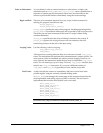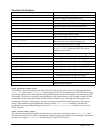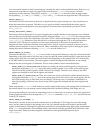
8 Advanced Camera Operation Manual
clear_until_trig( );
This function causes the CCD to enter clearing mode and continues clearing indefinitely until a trigger arrives.
Both the parallel and serial registers are continuously clearing (moving charge toward and into the serial
register then out). When the trigger signal arrives, the CCD finishes the current parallel shift (the maximum
delay is the time to shift 1 parallel row) and then stops clearing. Execution immediately continues with the
next script instruction. For more information concerning the pinouts and electrical specifications of the trigger
port, refer to your camera’s User Manual. (Please note that the current parallel shift is completed before the
camera begins integrating.)
expose
(exp_time);
The CCD exposes for
exp_time
milliseconds. This command usually appears immediately after
shutter_open
,
clear_parallel
, or
clear_until_trig
. Note that exposing is not equivalent to merely
waiting for the duration of the exposure time. During an exposure, voltage is applied to the CCD in a gridlike
pattern, to produce potential wells (pixels) and to keep the charge from drifting into adjacent cells. On some
CCDs, this voltage may be applied in either normal or MPP mode. The mode actually used for the exposure
reflects the most recently set parallel shifting mode (whether that mode was set to normal or MPP).
exp_time
may be set to zero, although this instruction becomes a “no operation” under those conditions. The
exp_time
variable maintains full precision up to a value of 65,535 milliseconds. After that point, the program creates
longer times through an internal loop counter that provides more precise timing than the scripting
loop_begin
command. Due to this mechanism, some values may be rounded off to a nearby value (for
example, prime numbers greater than 65,535 won’t be exactly represented). The maximum exposure length is
2^32 milliseconds (about 49 days). For more information on using exposure in conjunction with frame
transfer, consult your camera’s User Manual.
expose_until_trig( );
This function begins exposing immediately and continues exposing until a trigger signal arrives. The script
then continues with the next instruction. During the exposure, this applies voltage patterns to the CCD in
either normal or MPP modes (see
expose
). As with the regular
expose
function, this neither opens or closes
the shutter. For more information concerning the pinouts and electrical specifications of the trigger port, refer
to your camera’s User Manual.
expose_while_trig
(clear_first);
This function initiates a scripted version of the high-level bulb-mode exposure. If
clear_first
is 1, this
initially enters a continuous clearing mode, exactly like
clear_until_trig
. If
clear_first
is 0, the CCD
exposes while it waits for the trigger. In either case, once the trigger arrives, the CCD switches into an
exposing mode (either normal or MPP, see
expose
for more information), and continues exposing while the
trigger signal is present. As soon as the trigger ends, the exposure stops, and the script proceeds with the next
instruction. Note that this instruction is not redundant. You can’t use
expose_until_trig
in conjunction
with other instructions (such as
clear_until_trig
) to duplicate the function of this trigger, because a
trigger signal stops the exposure with
expose_until_trig
, while that same trigger signal starts (and
maintains)
expose_while_trig
. For more information concerning the pinouts and electrical specifications of
the trigger port, refer to your camera’s User Manual. clear_first must be either 0 or 1.
flash
(flash_time);
This function activates the flash circuit (a set of pins on the trigger port of many PVCAM cameras) and
continues applying power for
flash_time
milliseconds. In some cases, this may be used to activate devices
connected to the camera, such as an illuminator or filter wheel (although the flash signal differs from camera
to camera and is often not a TTL-compatible signal). For more information concerning the pinouts and
electrical specifications of the trigger port, refer to your camera’s User Manual.
flash_time
must be between 1
and 65,535, inclusive.


















